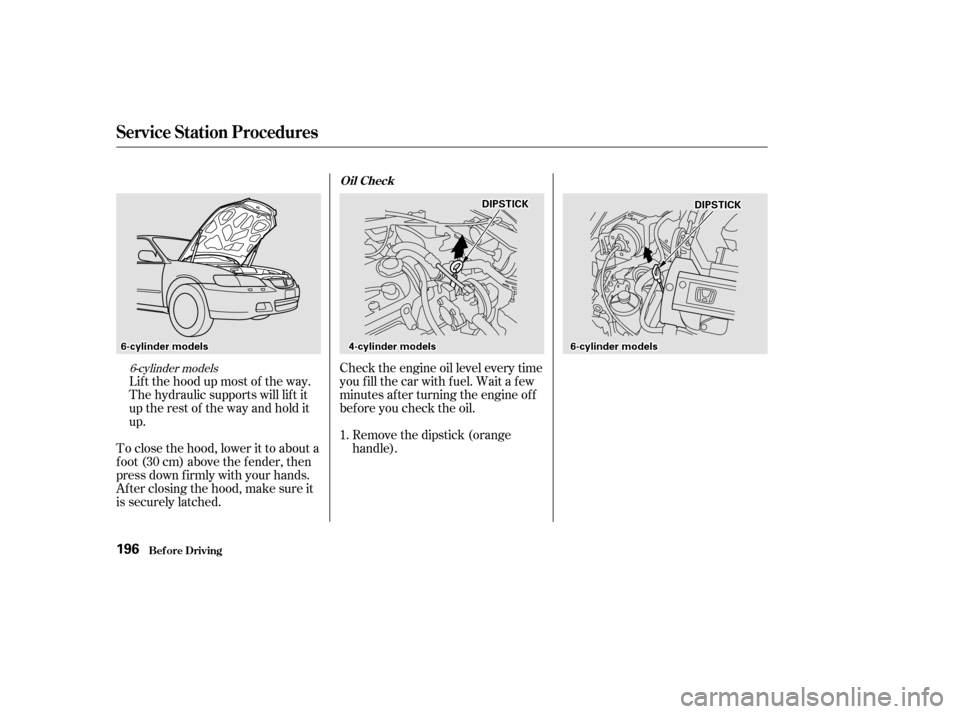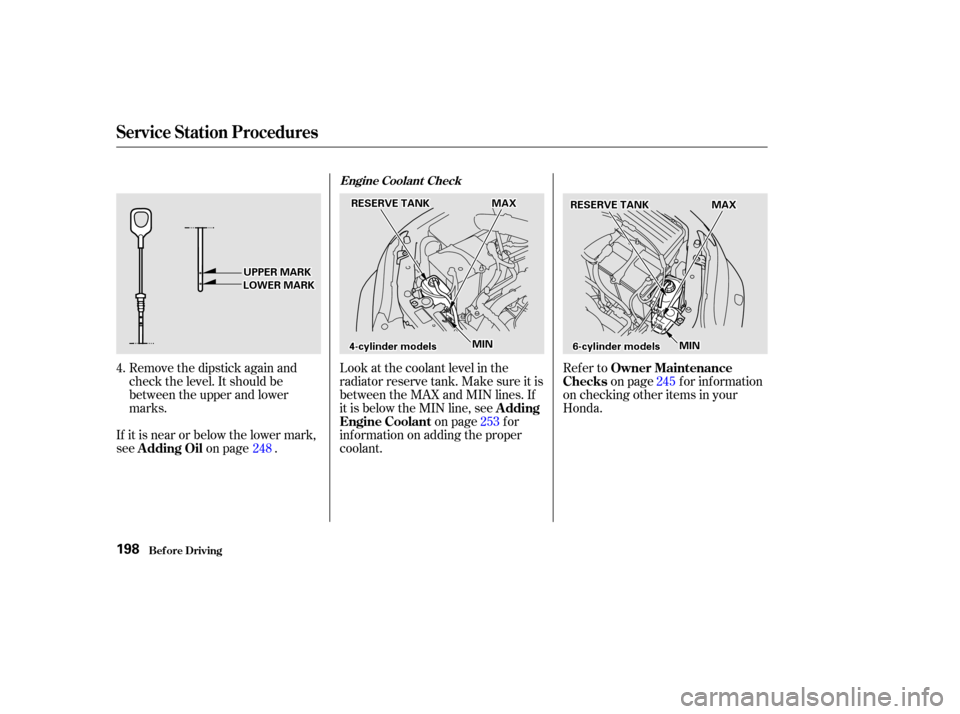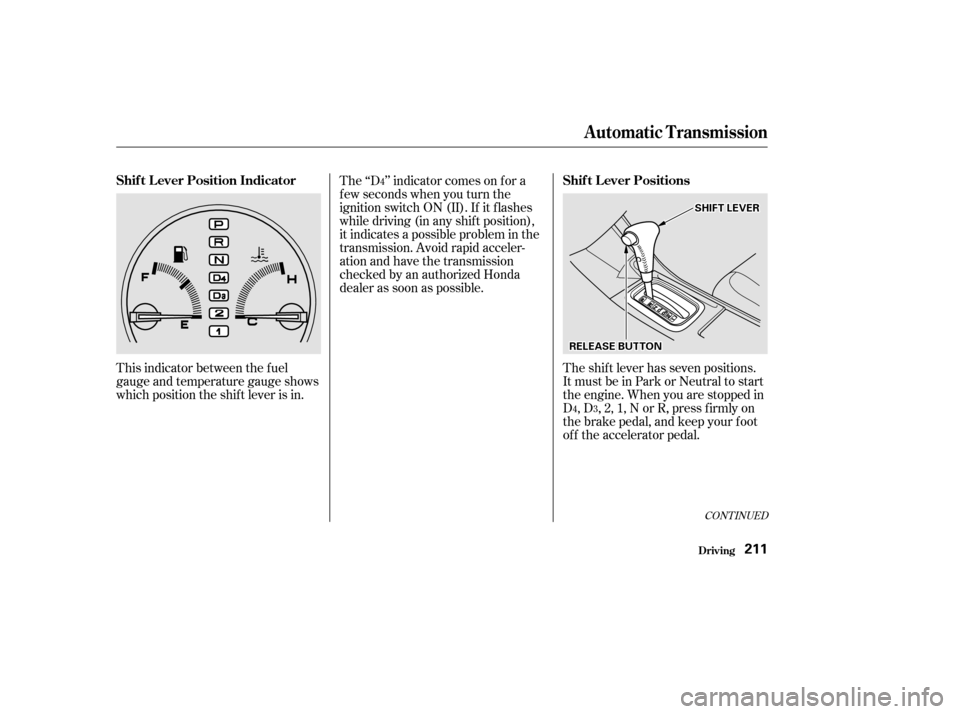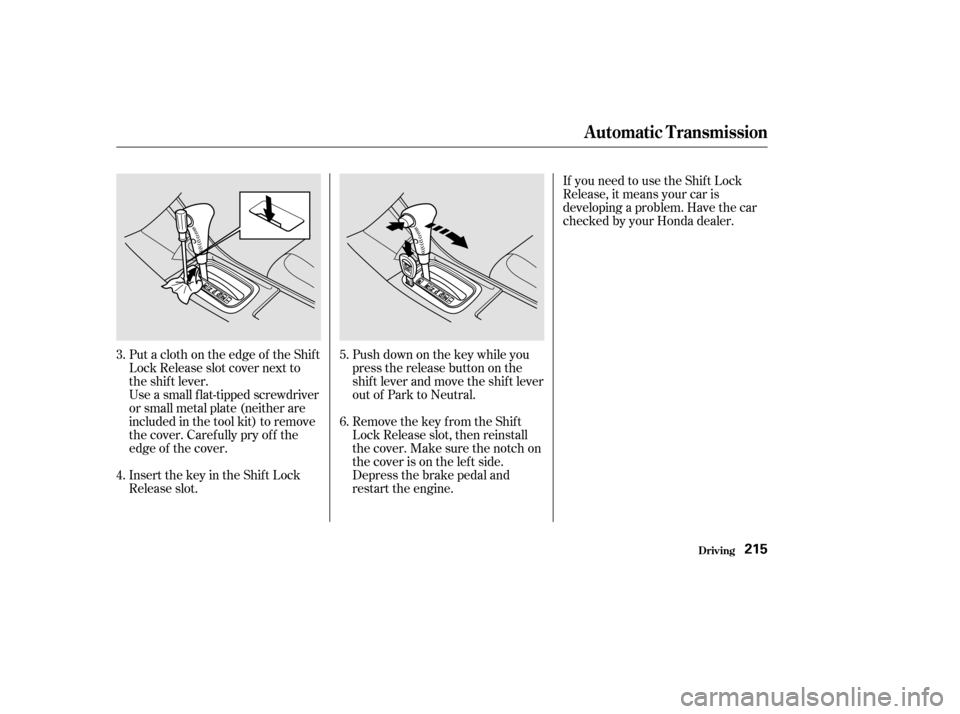check engine HONDA ACCORD COUPE 2002 CL7 / 7.G Owners Manual
[x] Cancel search | Manufacturer: HONDA, Model Year: 2002, Model line: ACCORD COUPE, Model: HONDA ACCORD COUPE 2002 CL7 / 7.GPages: 375, PDF Size: 4.89 MB
Page 51 of 375

If the SRS indicator light does not
come on after you turn the ignition
ON (II).
If the light stays on after the
engine starts.
If the light comes on or f lashes on
andoff whileyoudrive.
The SRS indicator light
alerts you to a potential
problem with your f ront airbags.
This light will also alert you to a
potential problem with your
automatic seat belt tensioners (page ). If the light comes on at any other
time, or does not come on at all, you
should have the system checked by
your dealer. For example:
If you see any of these indications,
your f ront or side airbags may not
deploy, your passenger’s side airbag
automatic cut-off system may not
work properly, or your seat belt
tensioners may not work when you
need them. See your Honda dealer
as soon as possible.
On models with side airbags, this
light will also alert you to a potential
problem with your side airbags or
passenger’s side airbag automatic
cut-off system (see page ).
When you turn the ignition ON (II),
this indicator will light brief ly then
go out. This tells you that the system
is working properly.
43
49
How the SRS Indicator L ight
Works
Additional Inf ormation About Your Airbags
Driver and Passenger Saf ety48
Ignoring the SRS indicator light
can result in serious injury or
death if the airbags, cut-off
system, or tensioners do not
work properly.
Have your vehicle checked by a
dealer as soon as possible if
the SRS light alerts you to a
potential problem.
Page 62 of 375

This indicator comes on f or a f ew
seconds when you turn the ignition
switch ON (II). It will then go of f if
you have inserted a properly-coded
ignition key. If it is not a properly-
coded key, the indicator will blink
and the engine will not start (see
page ).
This indicator also blinks several
times when you turn the ignition
switch f rom ON (II) to ACCESSORY
(I) or LOCK (0).
This light normally comes on f or a
f ew seconds when you turn the
ignition switch ON (II), and when
the ignition switch is turned to
START (III). If this light comes on at
any other time, there is a problem in
theABS.If thishappens,takethe
cartoyourdealertohaveitchecked.
With the light on, your car still has
normal braking ability but no anti-
lock. For complete inf ormation, see
page .
This light has two f unctions:
This indicator comes on when you
turn the ignition switch ON (II). It
is a reminder to check the parking
brake. Driving with the parking
brake not f ully released can
damage the brakes and tires.
If the indicator remains lit after
you have f ully released the
parking brake while the engine is
running, or if it comes on while
driving, it can indicate a problem
in the brake system. For complete
inf ormation, see page . See page .
1.
2.
75
332 219
329
Only on models equipped with ABS (see
page ) 200
Indicator L ights
Inst rument s and Cont rols
Immobilizer System
Indicator
Malf unction Indicator
Lamp
Anti-lock Brake System
(A BS) Indicator
Parking Brake and
Brake System Indicator
59
U.S. Canada
U.S. Canada
Page 67 of 375

4-cylinder models6-cylinder models
6-cylinder models
The gauge stays at the same f uel
level reading af ter you turn of f the
ignition. When you add f uel, the
gauge slowly changes to the new
readingafteryouturntheignition
switch back ON (II).
The needle returns to the bottom
after you turn off the ignition. The
gauge shows the f uel level reading
immediately af ter you turn the
ignition switch back ON (II). This shows how much f uel you have.
It is most accurate when the car is on
level ground. It may show slightly
more or less than the actual amount
whenyouaredrivingoncurvyor
hilly roads.
This meter shows the number of
miles (U.S.) or kilometers (Canada)
driven since you last reset it.
There are two trip meters: Trip A
and Trip B. Switch between these
displays by pressing the Select/
Reset button repeatedly. Each trip
meter works independently, so you
can keep track of two dif f erent
distances.
To reset a trip meter, display it, and
then press and hold the Select/Reset
button until the number resets to
‘‘0.0’’.
Both trip meters will reset if the car’s
battery goes dead or is disconnected. This shows the temperature of the
engine’s coolant. During normal
operation, the pointer should rise
from the bottom white mark to about
the middle of the gauge. In severe
driving conditions, such as very hot
weather or a long period of uphill
driving, the pointer may rise to near
the upper red mark. If it reaches the
red (Hot) mark, pull saf ely to the
side of the road. Turn to page f or
instructions and precautions on
checking the engine’s cooling
system.
324
Trip Meter
Temperature GaugeFuel Gauge
Gauges
Inst rument s and Cont rols64
Page 194 of 375

Bef ore you begin driving your Honda,
youshouldknowwhatgasolineto
use, and how to check the levels of
important f luids. You also need to
know how to properly store luggage
or packages. The inf ormation in this
section will help you. If you plan to
add any accessories to your car,
please read the inf ormation in this
section f irst..............................
Break-in Period .192
.........................................
Gasoline .192
.........
Service Station Procedures . 193
................
Filling the Fuel Tank . 193
....................
Opening the Hood .194
...............................
Oil Check .196
.........
Engine Coolant Check . 198
...............................
Fuel Economy .199
.....................
Vehicle Condition .199
...........................
Driving Habits .199
...
Accessories and Modif ications . 200
.............................
Carrying Cargo .202
Bef ore Driving
Bef ore Driving191
Page 199 of 375

Remove the dipstick (orange
handle).
Lif t the hood up most of the way.
The hydraulic supports will lif t it
uptherestof thewayandholdit
up.
To close the hood, lower it to about a
f oot (30 cm) above the f ender, then
press down f irmly with your hands.
Afterclosingthehood,makesureit
is securely latched. Check the engine oil level every time
you f ill the car with f uel. Wait a f ew
minutes af ter turning the engine of f
bef ore you check the oil.
1.
6-cylinder models
Service Station Procedures
Bef ore Driving
Oil Check
196
D D
I
IPP S
ST TI
ICCK K
6
6- -c
cy yl liinn d
de
err m
m o
od
de
ellss
6
6-
-c
cy yl liinn d
de
err m
m o
od
de
ellss
4
4--c
cy yl liinn d
de
err m
m o
od
de
ellss D
D
I
IPP S
ST TI
ICCK K
Page 201 of 375

Refer toon page f or inf ormation
on checking other items in your
Honda.
Look at the coolant level in the
radiator reserve tank. Make sure it is
between the MAX and MIN lines. If
it is below the MIN line, see
on page f or
inf ormation on adding the proper
coolant.
Remove the dipstick again and
check the level. It should be
between the upper and lower
marks.
If it is near or below the lower mark,
see on page .
4.
248 253245
Service Station Procedures
Bef ore Driving
Owner Maintenance
Checks
A dding
Engine Coolant
A dding Oil
Engine Coolant Check
198
M M I
INN
M
M
A
AX
X
M
M I
INN M
M
A
AX
X
R
RE
ES
SE ER
RV V E
E T
TA
A N
NK K
R
REES
SE ER
RV V E
E T
TA
A N
NK K
6
6- -c
cy yl liinn d
de
err m
m o
od
de
ellss
4
4- -c
cy yl liinn d
de
err m
m o
od
de
ellss
U
UP
PP
PE
ER
R M
M A
AR
RKK
L
LO OW WE ER
R M
M A
AR
RKK
Page 202 of 375

A cold engine uses more f uel than a
warm engine. It is not necessary to
‘‘warm-up’’ a cold engine by letting it
idle f or a long time. You can drive
away in about a minute, no matter
how cold it is outside. The engine
will warm up f aster, and you get
better f uel economy. To cut down on
the number of ‘‘cold starts,’’ try to
combine several short trips into one.
You can improve f uel economy by
driving moderately. Rapid acceler-
ation, abrupt cornering, and hard
braking use more f uel.
Always drive in the highest gear that
allows the engine to run and acceler-
ate smoothly.
The air conditioning puts an extra
load on the engine which makes it
usemorefuel.Turnoff theA/Cto
cut down on air conditioning use.
Use the f low-through ventilation
when the outside air temperature is
moderate.
Depending on traf f ic conditions, try
to maintain a constant speed. Every
time you slow down and speed up,
your car uses extra f uel. Use the
cruise control, when appropriate, to
increase f uel economy.
The condition of your car and your
driving habits are the two most
important things that affect the fuel
mileage you get.
Always maintain your car according
to the maintenance schedule. This
will keep it in top operating condition.
An important part of that mainte-
nance is the
(see page ). For
example, an underinf lated tire
causes more ‘‘rolling resistance,’’
which uses f uel. It also wears out
f aster, so check the tire pressure at
least monthly.
In winter, the build-up of snow on
your car’s underside adds weight and
rolling resistance. Frequent cleaning
helps your f uel mileage and reduces
thechanceof corrosion. 245
Vehicle Condition
Driving Habits
Owner Maintenance
Checks
Bef ore Driving
Fuel Economy
199
Page 209 of 375

Make sure all windows, mirrors,
and outside lights are clean and
unobstructed. Remove f rost, snow,
or ice.
Check that the hood and trunk are
f ully closed.Check the adjustment of the seat
(see page ).
Check the adjustment of the
inside and outside mirrors (see
page ).
Check the adjustment of the
steering wheel (see page ).
Make sure the doors are securely
closed and locked.
Fasten your seat belt. Check that
your passengers have f astened
their seat belts (see page ).Turn the ignition switch ON (II).
Check the indicator lights in the
instrument panel.
Start the engine (see page ).
Check the gauges and indicator
lights in the instrument panel (see
page ).
Check that any items you may be
carrying with you inside are stored
properly or f astened down
securely. Visually check the tires. If a tire
looks low, use a gauge to check its
pressure.
Youshoulddothefollowingchecks
and adjustments every day bef ore
you drive your car.
3.2.
1.
4. 5.
6.
7.
8.
9. 1510.
11.
12.
57
85
97 73 207
Preparing to Drive
Driving206
Page 214 of 375

CONT INUED
The shift lever has seven positions.
It must be in Park or Neutral to start
the engine. When you are stopped in
D,D,2,1,NorR,pressfirmlyon
the brake pedal, and keep your f oot
of f the accelerator pedal.
This indicator between the f uel
gauge and temperature gauge shows
which position the shif t lever is in. The ‘‘D ’’ indicator comes on f or a
f ew seconds when you turn the
ignition switch ON (II). If it f lashes
while driving (in any shif t position),
it indicates a possible problem in the
transmission. Avoid rapid acceler-
ation and have the transmission
checkedbyanauthorizedHonda
dealer as soon as possible.
43
4
Driving
Automatic Transmission
Shif t L ever Position Indicator
Shif t L ever Positions
211
S SHH I
IFFT T L
LEE V
V E
ER
R
R
RE EL
LEE A
A S
SEE B
BUUT TT
TO
ON N
Page 218 of 375

Put a cloth on the edge of the Shif t
Lock Release slot cover next to
the shift lever.
Use a small flat-tipped screwdriver
or small metal plate (neither are
included in the tool kit) to remove
the cover. Caref ully pry of f the
edge of the cover.
Insert the key in the Shift Lock
Release slot.Push down on the key while you
pressthereleasebuttononthe
shif t lever and move the shif t lever
out of Park to Neutral.
Remove the key from the Shift
Lock Release slot, then reinstall
thecover.Makesurethenotchon
the cover is on the lef t side.
Depress the brake pedal and
restart the engine.If you need to use the Shif t Lock
Release, it means your car is
developing a problem. Have the car
checked by your Honda dealer.
4. 5.
6.
3.
Automatic Transmission
Driving215